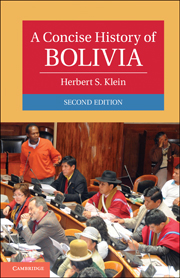Book contents
- Frontmatter
- Contents
- Preface to the Second Edition
- Preface to the First Edition
- 1 GEOGRAPHY AND PRE-COLUMBIAN CIVILIZATION
- 2 THE CREATION OF A COLONIAL SOCIETY
- 3 LATE COLONIAL SOCIETY: CRISIS AND GROWTH
- 4 REVOLUTION AND THE CREATION OF A NATION-STATE, 1809–1841
- 5 THE CRISIS OF THE STATE, 1841–1880
- 6 THE AGES OF SILVER AND TIN, 1880–1932
- 7 DISINTEGRATION OF THE ESTABLISHED ORDER, 1932–1952
- 8 FROM THE NATIONAL REVOLUTION TO THE COLD WAR, 1952–1982
- 9 CREATING A MULTIETHNIC DEMOCRACY, 1982–2002
- 10 THE EMERGENCE OF A MESTIZO AND INDIGENOUS ELITE, 2002–2010
- Political Chronology
- Tables
- Bibliography
- Index
- Titles in the series
10 - THE EMERGENCE OF A MESTIZO AND INDIGENOUS ELITE, 2002–2010
Published online by Cambridge University Press: 01 June 2011
- Frontmatter
- Contents
- Preface to the Second Edition
- Preface to the First Edition
- 1 GEOGRAPHY AND PRE-COLUMBIAN CIVILIZATION
- 2 THE CREATION OF A COLONIAL SOCIETY
- 3 LATE COLONIAL SOCIETY: CRISIS AND GROWTH
- 4 REVOLUTION AND THE CREATION OF A NATION-STATE, 1809–1841
- 5 THE CRISIS OF THE STATE, 1841–1880
- 6 THE AGES OF SILVER AND TIN, 1880–1932
- 7 DISINTEGRATION OF THE ESTABLISHED ORDER, 1932–1952
- 8 FROM THE NATIONAL REVOLUTION TO THE COLD WAR, 1952–1982
- 9 CREATING A MULTIETHNIC DEMOCRACY, 1982–2002
- 10 THE EMERGENCE OF A MESTIZO AND INDIGENOUS ELITE, 2002–2010
- Political Chronology
- Tables
- Bibliography
- Index
- Titles in the series
Summary
The shock of the election of 2002, followed by the massive, violent and ever more effective blockades by mestizos and indigenous groups created the background for the emergence of the first coherent and powerful mass political party led by mestizo and indigenous leaders. By the time of the presidential election of December 2005 most of the traditional parties had been replaced by a new non-indigenous party known as PODEMOS, while Morales and his MAS party emerged as the single most important party in the country. In December 2005, the MAS and the MIP, the other indigenous party, received 1.6 million votes out of the 2.9 million cast, or 56 percent of the total. Thus in just three short years all the traditional parties lost their importance and were replaced by new groupings of non-indigenous movements as well as a multiplicity of indigenous parties, the most important of which was the MAS, led by Evo Morales, which finally came to power in the 2005 election. For the first time in republican history a president was elected who defined himself as an indigenous person.
Not only were party politics changed after 2002, but new regional alliances were emerging in this more decentralized state. Slowly, and with some local variations, a new political division appeared in a fairly dramatic way between the core highland departments and a group of eastern and southern lowland departments (Beni, Pando, Santa Cruz, and Tarija), which formed what Bolivians began to call the media luna group (defined by its appearance on national maps as a half moon in their geographical relationship to the highland departments).
- Type
- Chapter
- Information
- A Concise History of Bolivia , pp. 264 - 296Publisher: Cambridge University PressPrint publication year: 2011



